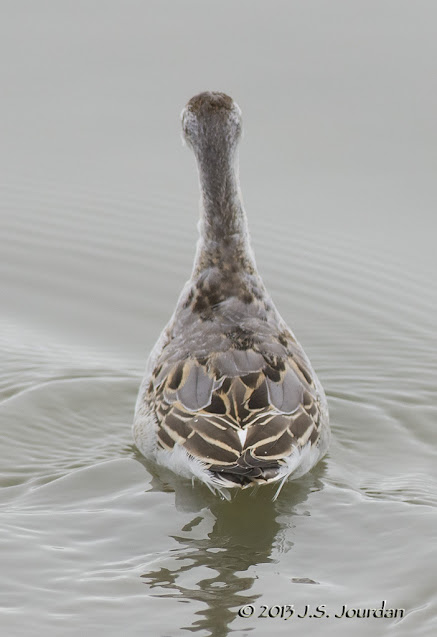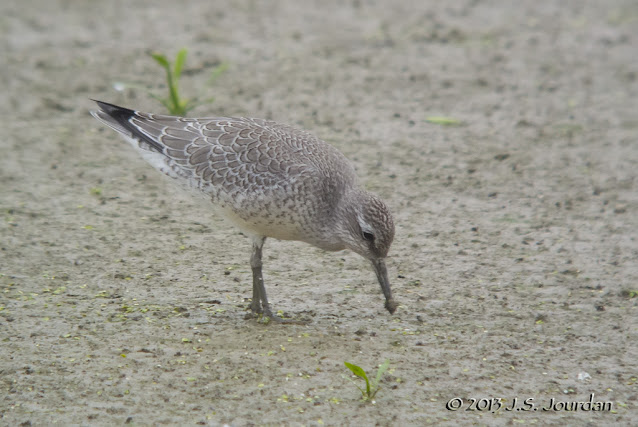Last Day of Shorebirding - 31 Aug 2013
It was quiet. No birds singing in the Walpatich and Lautenschlager Units. Only crickets and a couple of flyover Tree Swallows. As I approached the Humphries Unit a large colony of Great Egrets was roosting near shore. I stopped far enough back to scan the 120 birds for any Snowy Egrets. I found 5 Snowies along the far left side of the group, but they all flew before I could get off the bike to scope them.
I headed for the North Causeway via the dike separating Bloody Run and Long Pond Units. Song Sparrows bounced across the road in front of me, and the only way to ID them was by their long, Spizella tails. A Cooper's Hawk was roosting on a pole to my left as I road by, but took off the moment I slowed down. Same went for a Northern Harrier, so I continued riding toward the North Causeway and Cell 5.
I spotted the American White Pelican in Cell 5 almost immediately. It was along the far shoreline among a pair of Great Egrets, and dwarfed them in size. An American Avocet in basic plumage was also there, and as I scanned the shoreline I spotted five Short-billed Dowitchers and a handful of Least and Semipalmated Sandpipers.
I spent a few minutes along the dike at the north end of Cell 4 scanning the large sand spit for Buff-breasted Sandpipers, but dipped. I then rode toward Cell 3 where I ran into Ming Yao and chatted with him for a few minutes. A juvenile Baird's Sandpiper was foraging on the road ahead of me, so I rode slowly and tried to grab a photo or two in between its short flight bursts.
Out on the mudflats the Red Knot was foraging about 60' away, so I spent some time trying to digiscope it. A pair of White-rumped Sandpipers were also nearby, and really stood out in the overcast light. By now their plumage has grayed enough to really enhance the white eyebrows. A pair of American Avocets were still out on the edge of the mudflats among dozens of Short-billed Dowitchers.
As I headed back I ran into Todd Palgut, who alerted me to a possible pair of Long-billed Dowitchers in the NE corner of the Humphries Unit, so I rode over to verify. They were far back in the vegetation but almost completely molted into winter grays.
I got back to the car just before the rains hit. It was a good season, and I'll miss the place until 2014.
Pte. Mouillee SGA (permit required Sep 1-Dec 15), Monroe, Michigan, US
Aug 31, 2013 7:00 AM - 11:00 AM
Protocol: Traveling
8.078 mile(s)
Checklist Comments: Despite almost 2" of rain overnight and overcast/muggy temps this morning I had to take one final spin around Pt. Mouillee SGA. I figured that the dark and overcast skies would be poor for photos this morning, but I could at least survey the units before the SGA closes Sept 1 for hunting.
18 species
American Avocet (Recurvirostra americana) 1 Cell 5; basic plumage
Short-billed Dowitcher (Limnodromus griseus) 5
Long-billed Dowitcher (Limnodromus scolopaceus) 2 As I headed back I ran into Todd Palgut, who alerted me to a possible pair of Long-billed Dowitchers in the NE corner of the Humphries Unit, so I rode over to verify. They were far back in the vegetation but almost completely molted into winter grays. Plump dowitchers.
Wilson's Phalarope (Phalaropus tricolor) 3 Continuing; Cell 3; molting juveniles and 1 adult
Red-necked Phalarope (Phalaropus lobatus) 2 Cell 3; black eye mask distinctive to separate from Wilson's phalarope. Also black back w/ orange fringes.
Red Knot (Calidris canutus) 1 60' away on mudflat in Cell 3; Pale gray w/ white eyebrow and hint of peach on breast. Fish-scale white fringing and stocky straight bill.
Stilt Sandpiper (Calidris himantopus) 2
Baird's Sandpiper (Calidris bairdii) 1
White-rumped Sandpiper (Calidris fuscicollis) 1
Least Sandpiper (Calidris minutilla) 6
Semipalmated Sandpiper (Calidris pusilla) 6
American White Pelican (Pelecanus erythrorhynchos) 1 Cell 5
Snowy Egret (Egretta thula) 5 Humphries Unit among 120 larger Great Egrets.
Great Egret (Ardea alba) 120 As I approached the Humphries Unit a large colony of Great Egrets was roosting near shore. I stopped far enough back to scan the 120 birds for any Snowy Egrets. I found 5 Snowies along the far left side of the group, but they all flew before I could get off the bike to scope them.
Northern Harrier (Circus hudsonius) 1
Cooper's Hawk (Accipiter cooperii) 1
Tree Swallow (Tachycineta bicolor) 2
Song Sparrow (Melospiza melodia) 6
View this checklist online at https://ebird.org/checklist/S1
This report was generated automatically by eBird v3 (https://ebird.org/home)
Aug 31, 2013 7:00 AM - 11:00 AM
Protocol: Traveling
8.078 mile(s)
Checklist Comments: Despite almost 2" of rain overnight and overcast/muggy temps this morning I had to take one final spin around Pt. Mouillee SGA. I figured that the dark and overcast skies would be poor for photos this morning, but I could at least survey the units before the SGA closes Sept 1 for hunting.
18 species
American Avocet (Recurvirostra americana) 1 Cell 5; basic plumage
Short-billed Dowitcher (Limnodromus griseus) 5
Long-billed Dowitcher (Limnodromus scolopaceus) 2 As I headed back I ran into Todd Palgut, who alerted me to a possible pair of Long-billed Dowitchers in the NE corner of the Humphries Unit, so I rode over to verify. They were far back in the vegetation but almost completely molted into winter grays. Plump dowitchers.
Wilson's Phalarope (Phalaropus tricolor) 3 Continuing; Cell 3; molting juveniles and 1 adult
Red-necked Phalarope (Phalaropus lobatus) 2 Cell 3; black eye mask distinctive to separate from Wilson's phalarope. Also black back w/ orange fringes.
Red Knot (Calidris canutus) 1 60' away on mudflat in Cell 3; Pale gray w/ white eyebrow and hint of peach on breast. Fish-scale white fringing and stocky straight bill.
Stilt Sandpiper (Calidris himantopus) 2
Baird's Sandpiper (Calidris bairdii) 1
White-rumped Sandpiper (Calidris fuscicollis) 1
Least Sandpiper (Calidris minutilla) 6
Semipalmated Sandpiper (Calidris pusilla) 6
American White Pelican (Pelecanus erythrorhynchos) 1 Cell 5
Snowy Egret (Egretta thula) 5 Humphries Unit among 120 larger Great Egrets.
Great Egret (Ardea alba) 120 As I approached the Humphries Unit a large colony of Great Egrets was roosting near shore. I stopped far enough back to scan the 120 birds for any Snowy Egrets. I found 5 Snowies along the far left side of the group, but they all flew before I could get off the bike to scope them.
Northern Harrier (Circus hudsonius) 1
Cooper's Hawk (Accipiter cooperii) 1
Tree Swallow (Tachycineta bicolor) 2
Song Sparrow (Melospiza melodia) 6
View this checklist online at https://ebird.org/checklist/S1
This report was generated automatically by eBird v3 (https://ebird.org/home)






















Comments
Post a Comment
Please leave a comment. I will try to respond ASAP.